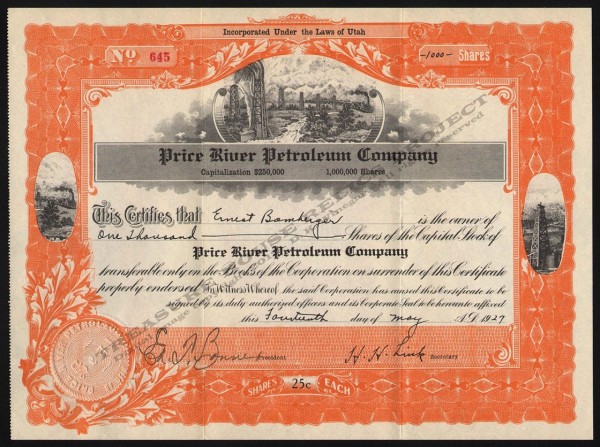Pennsylvania Oil & Development Company
The Pennsylvania Oil & Development Company began during a banking crisis and had a brief life in the Montana oilfields. Established in 1922, the exploration company was capitalized at $1 million with its stock offered at 10 cents per share.
Principal operations were out of Forsythe, in south central Montana, with $200,000 of the capitalization subscribed by the incorporators and directors of the company, C.E. Morse, H.G. Young and Margaret Young. Holdings included leases in the “Porcupine Dome” in Rosebud County, Montana, as well as in Greybull, Wyoming.
Pennsylvania Oil & Development was one of several petroleum companies drilling “wildcat” wells in Carbon County, Montana. The county, established in 1895, was named after the abundant coal supplies in its 2,026 square mile area. It was also home to the state’s first oil well, drilled in 1901 at Kintla Lake, now part of Glacier National Park.
Trade publications followed Pennsylvania Oil & Development’s Carbon County drilling operations, including an apparently noncommercial oil well in 1922 (Northwest Quarter of the Northeast Quarter of Section 37, Township 7 South, Range 24 East, Public Land Survey System, PLSS). A year later, the company continued its wildcat drilling with another attempt, now joining with the Red River Oil Company for a test well in Section 35, Township 7 South, Range 24 East (PLSS).
By June 1922, Red River Oil had abandoned the project while retaining a one-eighth working interest. Two years later, Pennsylvania Oil & Development was still solvent and drilling on Black Butte in Carbon County. Its latest well reportedly reached a depth in excess of 2,000 feet with a producing zone anticipated in the “Madison Lime” formation.
Then news about Pennsylvania Oil & Development abruptly stopped. After 1924, drilling reports about the company’s wells disappeared from trade publications. A clue may be found in the 1920s banking crisis, described by Montana’s superintendent of banks as a “veritable nightmare.”
Between 1921 and 1926, no state had more bankruptcies than Montana – with 191 banks failing in the last few months of 1924 alone. It seems likely under these circumstances that both the founders of the petroleum exploration company and the shareholders were left with worthless stock certificates.
___________________________________________________________________________________
The stories of exploration and production companies joining petroleum booms (and avoiding busts) can be found updated in Is my Old Oil Stock worth Anything? The American Oil & Gas Historical Society preserves U.S. petroleum history. Please support this AOGHS.ORG energy education website. For membership information, contact bawells@aoghs.org. © 2018 Bruce A. Wells.
___________________________________________________________________________________


